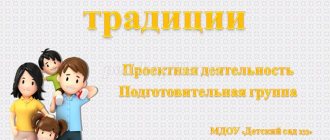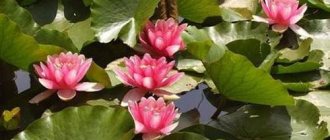Project “My Favorite City” (preparatory group)
Goal: - encourage children to speak out; — test children’s knowledge of city
, your home address.
2. Cognitive - research. Drawing up a map of the street where our kindergarten is located.
2) Independent activity of children. Looking at a map - city
(check the boxes for the most interesting places
in the city
, places where the children have already been).
3) GCD. Design “The area in which our kindergarten is located”
.
Goals: - expand and clarify children’s ideas about the area in which their kindergarten is located; – learn to work collectively, discuss details of work; - develop imagination.
Afternoon.
1) Role-playing game “Streets of my hometown ”
.
Goal: - to help children divide the group
into supposed streets with different play centers organized on them
(hospital, store, pharmacy, police, post office, kindergarten)
;
- develop free communication with adults and children during the game
2) D/i “Lay down a monument”
.
The first half of the day
1) Group/subgroup activities
:
1. Children’s story about interesting places in the city
, where they have already visited.
2. CHHL. Reading poems about your hometown
.
2) Independent activity of children. Looking at books and photographs.
3) GCD. Cognition: “The history of the emergence of our native city ”
.
Goals: - consolidate children’s knowledge about their hometown
;
— introduce the history of the city and its founder
; - cultivate interest in the history of their native land.
Afternoon.
1) Educational - research “Compilation of the Red Data Book of the native land”
.
Purpose: - storytelling, showing illustrations of animals living in our area.
2) Conversation: “What interesting things did you see and remember when visiting the museum?”
3) Drawing on the theme “Animals of our native land”
.
4) Work with parents: offer to find information about the number of streets in the city
and whose names the streets are named after.
Day 5
The first half of the day
1) Group/subgroup activities
:
Compiling and guessing riddles on the topic “My favorite places in my city ”
.
2) Independent activity of children.
Cognitive - research. Looking at illustrations of industrial facilities in our city
.
Afternoon.
1) Educational fairy tale. Goal: - listening to fairy tales and memorizing small genres of oral - folk art from the collection “In a Certain Kingdom”
.
2) Productive. Making the album “My City ”
.
3) D/i “Guess where I am”
.
Project result
:
Knowledge gained during the project
, helped to increase the importance of patriotic education of children and the formation of patriotic feelings among preschoolers.
Parents and educators were convinced of how relevant the topic of studying one’s hometown is
.
The project
interested children and adults, united parents and children in raising future citizens of their
city and country
.
Social and pedagogical local history project at the preschool educational institution “Nytva - my hometown”
- March 14, 2016
Conference “Project activity in an educational institution - 2016”
Nomination “Pedagogical project in a preschool institution”
“Only those who love, appreciate and respect what has been accumulated and preserved by the previous generation can love the Motherland, recognize it, and become a true patriot.”
S. Mikhalkov
Relevance of the project
During childhood, the basic qualities of a person are formed. It is especially important to imbue the receptive soul of a child with sublime human values, to generate interest in the history of Russia, his native land and city.
Love for loved ones, for kindergarten, for one’s hometown and home country, play a significant role in the development of a child’s personality. Acquaintance of children with their native land: with historical, cultural, national, geographical, natural features - forms in them such character traits that will help them become a patriot and citizen of their Motherland. After all, vivid impressions of one’s native nature and the history of one’s native city, received in childhood, often remain in a person’s memory for the rest of his life.
The basis of patriotic education is moral, aesthetic, labor, and mental education. In the process of such versatile education, the first shoots of civic-patriotic feelings arise.
Project hypothesis
If during the implementation of the project a system of work is created to familiarize children with their hometown, then this will allow the child to understand that every person, regardless of age, is part of his people, that every person has a Motherland, places near and dear to him.
Project goal : Implementation of feelings of an integrated approach to education in the spirit of patriotism. Introducing preschoolers to the history and culture of their hometown, local attractions, nurturing love and affection for their native land.
Project objectives:
- Develop a caring attitude towards the city, its attractions, cultural values, and nature.
- To develop coherent speech, enrich and activate children’s speech, teach them to think freely and fantasize.
- Cultivate a sense of pride for your fellow countrymen, an emotional and value-based attitude towards the region.
- Increase the interest and competence of parents in this issue, involve them in the implementation of the project.
Project methods
- Observation
- Cooperative games
- Cognitive and gaming activities
- Conversations
- Excursions
Acquisition of social communication skills by preschool children with adults.
The project implementation period is 1 year.
Participants: teacher, music director of the preschool educational institution, parents.
Target group: children from 5-6 years old.
Scale: May 2014 – May 2015
This project includes 6 blocks:
- Block 1: “My hometown.”
- Block 2: “History of the city.”
- Block 3: “Flora and fauna of the Nytvensky district.”
- Block 4: “Sights of the city.”
- Block 5: “People who glorified the city.”
- Block 6: “A significant enterprise of the city is the Nytvensky Metallurgical Plant.”
Project part (project stages)
I Preparatory stage
- Study of theoretical issues.
- Selection of methodological and fiction literature.
- Development of notes to familiarize children with their hometown.
- Parent survey.
- Diagnostics of children.
- Establish cooperation with the station for young naturalists, the Nytvensky Museum of Local Lore, the library, the Spoon Museum, and the sports school.
- Prepare an exhibition of children’s works “My Family”, “My Favorite City”, a Photo Exhibition together with parents “Me and My City”.
- Decoration of the locker room: photo exhibition “Nytva is my hometown.”
- Exhibition of drawings about the city.
- “My hometown”: introduce children to the main objects of the city, teach them to navigate the streets closest to the kindergarten.
II Main stage
- Creating a local history corner in the group.
- Collection of photo, video and audio materials about your hometown.
- Excursions to the local history museum, the station for young naturalists, the library, the sports school, the art school, and the Soldier’s monument.
- Carrying out joint holidays and entertainment with parents.
- Design of photo albums “Together a friendly family”, “Poets and artists of Nytva”, “My city - my small homeland”.
- Creation of card files of proverbs and sayings.
I block. "My hometown"
- Introduce children to the main objects of the city. Learn to navigate the streets closest to the kindergarten.
- NOD "The city where I live"
- Decoration of the photo exhibition “Nytva - my hometown” in the locker room
- Drawing together with parents “My street, where I live”
- Exhibition of drawings about the city.
II block. "City `s history"
- Give primary information about the history of the city. Introduce the coat of arms of Nytva.
- Excursion to the local history museum - the history of the emergence and development of the city (lesson cycles).
Working with the family: ask great-grandparents about the history of the city. Invite to a meeting with the children. Creation of the album “History of the Development of the City”. Getting to know the city's coat of arms.
III block. "Nature of the native land"
- Excursion to the station for young naturalists.
- Conversation “Fauna and flora of the Nytvensky district.”
- D/game “Name the animals and their babies.”
- Evening of mysteries.
- Conversation: “The Red Book of the Kama Region.”
- Exhibition of drawings “Animals of our forests”.
IV block. "Sights of our city"
- Conversation “The pearl of our city - Nytvensky pond.”
- Creation of a photo exhibition “Sights of the city of Nytva”, “Memorable places”.
- Excursion to the Spoon Museum.
- Walks to the pond.
- Exhibition-collage “I’m proud of you, my native land.”
V block. "People who glorified the city"
Meetings with interesting people:
- WWII veterans
- Poets
- Artists
- Honorary residents of the city of Nytva
VI block. “Significant enterprises of the city - Nytvensky Metallurgical Plant”
- Excursion to the metallurgical plant museum.
- Conversations: “Professions of my parents.” Drawing “My Dad”, “My Mom”. Family leisure “Different professions are needed - all professions are important.”
Stage III: final
- Final diagnosis of children.
- Repeated survey of parents.
- A joint holiday with parents.
- Broadcasting the project at different levels.
Expected results:
- Children should know and name their city, city enterprises, their significance, city symbols, and attractions.
- Children should develop a sense of pride in their city and a desire to keep it clean and beautiful.
- Children and parents will take an active part in exhibitions, competitions, sports and patriotic events, discussions and other activities.
- Children will show attention and respect to veterans and elderly people, and will be able to provide all possible assistance.
- Teachers and parents will expand their knowledge about the Perm region and the city of Nytva.
- Team building parents-educators-children.
Used Books
Kontsirskaya L. A. “Where the Motherland Begins,” M. T. Ts. Sphere 2005.
Aleshina N.V. “Introducing preschoolers to their hometown.” Patriotic education of preschool children.
Rybakov I. Familiarization with one’s hometown as a means of patriotic education, Preschool Education, 2003 No. 6 pp. 44-55
Yudina N. Patriotic education (from the experience of teachers of preschool educational institution No. Armavir) “A child in kindergarten.”
Author: Bezmaternykh Tatyana Vyacheslavovna, teacher I qualification category, teaching experience 29 years, MBDOU CRR kindergarten No. 16, Nytva, Perm region.
Goal and work plan
We live in Lipetsk, and this is what we will talk about in our project.
We, as always, do a little more than we are asked. This time we decided not only to include photographs of the city in the project, but also to add information about the city’s coat of arms, the date of its foundation and decorate our creation with a poem.
So, here are our goals:
- Replenish your knowledge about the sights of Lipetsk.
- Create a mini-book “Hometown”.
Yes, yes, we decided to format the project in the form of a small book.
The following steps will lead us to our goals:
- Find information on the Internet about the coat of arms of Lipetsk and the date of its foundation.
- Find a beautiful poem about the city of Lipetsk on the Internet.
- Find beautiful photographs on the Internet with views of Lipetsk.
- Write descriptions for the found photographs.
- Make a mini-book.
- Present the project in class.
And a few more lines about the workbook. It also contains a couple of pages for this work.
Unlike the assignment we received in first grade where the project could be completed directly in the workbook, this time the workbook is designed for a different purpose.
On its pages, children are invited to post:
- basic materials on the project (photos, background information);
- write down a plan for speaking at a presentation;
- evaluate your work and express gratitude to those who helped make the project.
We begin!
Textbook assignment
So, on the page with the project, the authors of the textbook tell us about Seryozha and Nadya; most likely, they are brother and sister. The children live in Moscow - this is their hometown.
They walked with their parents around Moscow and photographed various beauties. Their photographs are given as an example on the pages of the textbook.
So we are invited to do the same. Go and walk around your hometown with a camera in your hands, take photos. And then use these photographs to create a project.
That’s what it says: “Prepare a photo story about your hometown (village).”
The question immediately arises: “How to formalize it?” And here is the answer: “It can be designed in the form of a book, a stand, a wall newspaper.”
In general, everything is clear. We can start. As usual, we start by setting a goal and developing a work plan.




